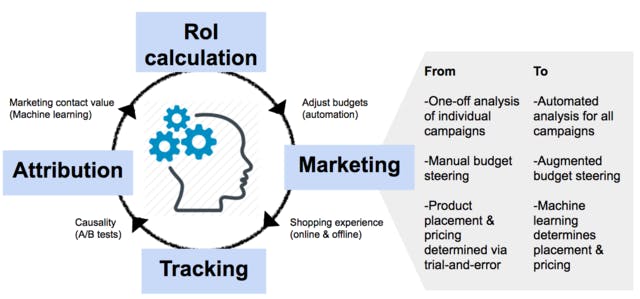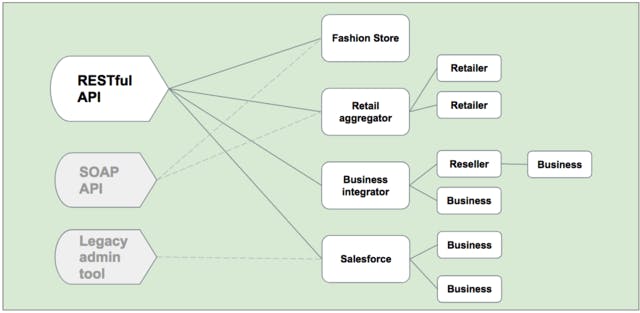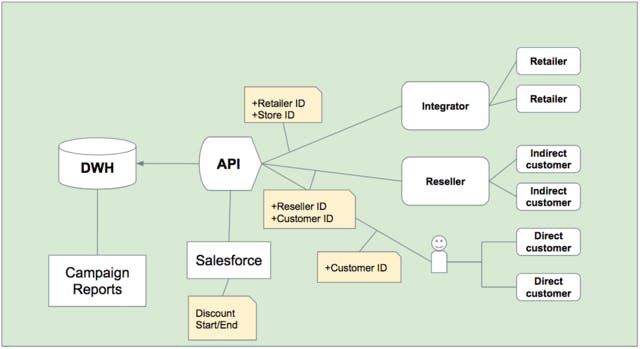Improving Efficiency in Offline Campaigns
How Zalando uses an API to drive marketing profitability
Using an API to drive marketing profitability: a gift card study
Gift cards are becoming increasingly popular in the US and Europe. For time-pressed consumers trying to find a convenient gift for friends and family, gift cards are an easy solution, and it shows: gift cards are projected to grow at a 24% Compound Annual Growth Rate (CAGR) until 2023, According to Allied Market Research. Brands reap the benefits too: they can use them to engage their best customers to onboard family and friends, driving profitable sales.
Zalando wants to build Europe’s most beloved gift card, but the market is competitive. This blog post outlines the challenges of entering the market, describes our technical approach, and lists some key learnings.
Online - brave new world
Successful online businesses use data to their advantage. They make marketing decisions based on data from their own sites and those of partners. Data science and machine learning are increasingly applied to aggregate campaign outcomes into insights and provide guidance or even fully steer marketing investments. As a result, marketing processes are being digitized rapidly.

Offline - data scattered throughout proprietary systems
Yet to succeed in the market, online marketing prowess only brings you so far. To reach consumers on a broad scale, a brand must sell its gift cards through leading retail stores, as well as offer them via employee benefit and loyalty programmes.
E-commerce players like Zalando are used to easy integration with partners and have access to a wealth of marketing and sales data. Providing comparable insights on campaigns executed with brick-and-mortar retailers and businesses presented us with some tough nuts to crack, so we took a look at our business objectives.
I. Business Objectives
1. Integrate with gift card distribution networks Unlike e-commerce, gift cards are not only sold online: a very substantial share is actually sold through retail and to businesses. A sprawling ecosystem of aggregators and resellers serves tens of thousands of businesses and retail stores. If a brand wants to reach consumers on a broad base, it has to digitally integrate this vast ecosystem. But how do you find an approach that scales?
** 2. Harvest data in real time Using real-time data allows e-commerce players to observe the effects of campaigns in real time, giving them superior control over their investments. In the offline world however, data points are few and far between and are constrained to monthly CSV reports. So how do you enable real time data insights** into sales via brick-and-mortar businesses?
3. Understand Return on Investment (ROI) The right data makes the difference between running a profitable campaign and losing money. In this brave new world, ROI steering has become a mandate. An apples-to-apples comparison between online, retail and business campaigns demands using the same tools and metrics. Yet how do you A/B test campaigns in a brick-and-mortar world?
II. Digitally Integrating an Ecosystem
Our data strategy follows a simple mantra: a single API harvests all commercially relevant data from every partner in real time. Standardized data backhaul reduces complexity and frees up engineers and analysts to focus on initiatives that create business value. Real time data enables timely and precise business steering as well as improved operations.
1. Migration to RESTful API - challenges

a. Idempotency Since gift cards represent financial value for the customer, it‘s important to provide a robust and fault-tolerant way of operations. Errors, such as network problems, service interruptions, or user error are a fact of digital life. We handle incidents based on best practices, yet one of the most important cornerstones for our API is idempotency. We require our partners to provide a unique operation identifier on every call. Based on these identifiers, we can ensure that the required operation will be executed only once, even in the case of repeating calls, which can happen due to connectivity interruptions.
b. Scalability To address requirements towards a modern partner API, we designed our API to be scalable to address future growth. During design and implementation, we took substantial efforts to determine performance limits and push beyond these limits. Load testing is the best friend of the developer, allowing you to prove that your service is fulfilling the business requirements. As a nice side effect it may expose hidden problems in the implementation. And it‘s always better to find your problems and solve them before they affect actual customers.
c. Security Gift cards represent value, thus any processes that touch a gift card code must adhere to the highest standards of compliance. We worked closely with internal auditing personnel to identify weaknesses in our process and address these. Our basic mantra is that a gift card code should only be touched by the customer. This meant harmonizing diverse existing processes, such as manual distribution by mail, transfer to SFTP servers or upload to websites, towards a common, secure process.
2. Backhaul of commercial data - challenges

a. Standardization Though brick and mortar businesses harvest a wealth of commercial data from their networks, they use proprietary schemes, making further processing of any such data almost impossible. We decided to mandate the provision of core sales data from partners and customers. While this sounds somewhat onerous, it was essential for a solution designed to address business requirements.
b. Real time To enable marketing executives to make the right decisions, data needs to be available with little delay. In today’s increasingly competitive markets, a monthly report is not a solution; it is a problem. Using our API for data backhaul gets rid of that headache.
c. Attribution To track how campaigns perform requires attribution to the specific partner that executed a particular campaign. In retail this means knowing which retailer sells a particular gift card product at a particular time. Combining such data with Salesforce-based campaign planning enabled us to assign discounts to individual cards.
d. A/B testability To execute A/B tests in the real world of retail demands the ability to execute a campaign in two specific, comparable geographies. Thus, the retailer must be able to restrict campaigns by region, which is a substantial challenge. In addition, analysis of results requires information about the specific store that sold an individual card.
III Learnings
1. Plan efforts and timings generously Migrating an operative API that connects external partners is a challenge. Any bug will directly impact customers and revenue, so all inherent risks need to be addressed. Partners are generally loath to change a running system, thus migration takes considerable time, during which any systems and processes must be operated in parallel.
2. Focus on the what, be flexible on the how Winning over partners to change a process is never easy. What made the difference was pragmatism; focusing on outcomes while being flexible on the solution. We had to accept some constraints and put in some extra effort. But this way, we got our partners to onboard in a timely way.
3. Data sharing requires a win-win proposition While the strategic value of data is clear to businesses, the rationale to share such data with partners is less so. Today, sharing data with offline partners is mostly restricted to downloadable monthly reports. Providing extended data in real time requires changes to systems and processes. To decide such discussion in your favor, you must think through what benefits such change will provide to your partner.
4. Real time data - a treasure trove for machine learning Our data team was asked to provide advice on a number of incidents where gift cards were being misused in inventive ways. The metadata collected for marketing purposes proved extraordinarily useful in such cases. Using machine learning, we were able to precisely identify patterns of misuse. Real time data enables real time decisions.
IV Conclusion
While it takes considerable effort and persistence to get the necessary metadata from partners operating in the offline world, our early investments in a modern data backhaul are paying off by providing the transparency we require.
The concrete and tangible benefits for us are:
- Full attribution of discounts granted by retail and business to profit calculation
- Track campaign impact on a daily basis
- Ability to steer on Return on Investment
- A/B test offline campaigns across geographical regions
We're hiring! Do you like working in an ever evolving organization such as Zalando? Consider joining our teams as a Software Engineer!





